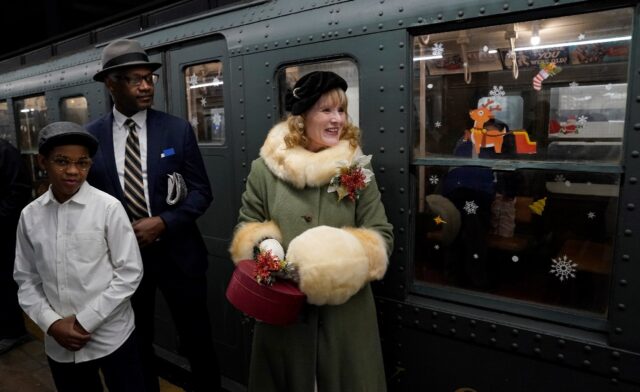Nearly a century after the New York subway introduced its iconic “R1-9” fleet, the agency is putting some of the railcars back into service — and city residents are jumping on board.
The Metropolitan Transport Authority (MTA), which operates the Big Apple’s sprawling — and sometimes detested — subway system, is reintroducing R1-9s onto the tracks for a limited time, complete with early 20th century accoutrements.
In one car, for instance, a 1960s-style advertisement pays tribute to “the late president” next to a black-and-white photo of John F. Kennedy.
The blast from the past — made possible through a collaboration between the MTA and the Transit Museum — is being celebrated by New Yorkers, with some dressing up to match the part.
On a cold December Sunday morning, travelers in period-appropriate costume stand alongside passengers in contemporary fashion, forming a delightfully anachronistic mix.
Latoya Fulton, a 40-year-old Bronx native who brought her daughter along to share the experience, savors the nostalgia.
“I remember riding the train with my mom, going to Yankee Stadium,” she told AFP. “I remember just being, just happy looking out the window when we went outside for the outside stop.”
Paddle ceiling fans swirl overhead and incandescent light bulbs lend a theatrical vibe.
With no public address system on the vintage trains, a volunteer crewmember is left to call out the approaching stops.
‘Test of time’
Rider Fox Hutson dons a military cap and camouflage jumpsuit for the journey, dressing as if he were a US soldier returning from war.
“The past is going away, but this is the only way to preserve it and see some nice people,” the 53-year-old photographer said. “It’s a test of time, and these things still work.”
Though the R1-9 train cars were widespread for decades since being introduced in the 1930s, they were fully withdrawn from service by 1977.
The cars represent a touchstone in US history, inspiring artists like jazz legend Duke Ellington with his song “Take the A Train.”
“This was the first mass transit that grew the city,” said Todd Glickman, a volunteer with the Transit Museum.
“It used to be in the early part of the 1900s, people would have to live very close to where they worked and where they went to school,” he went on to explain.
“And because of the advent of the subway system in 1904, people could travel in a short amount of time and that’s what created the growth of the city.”

COMMENTS
Please let us know if you're having issues with commenting.